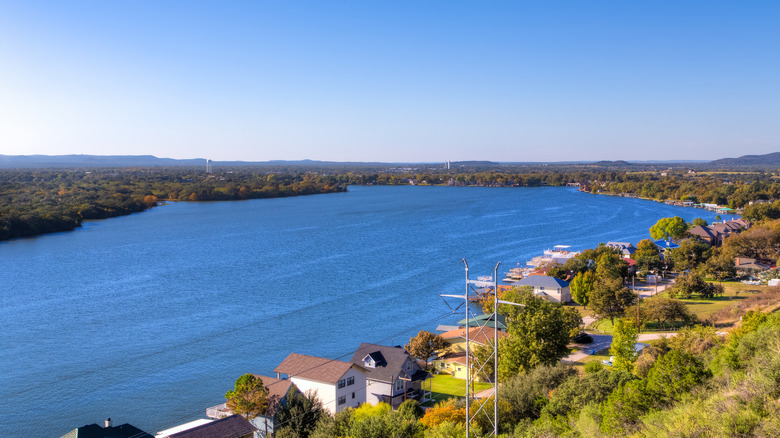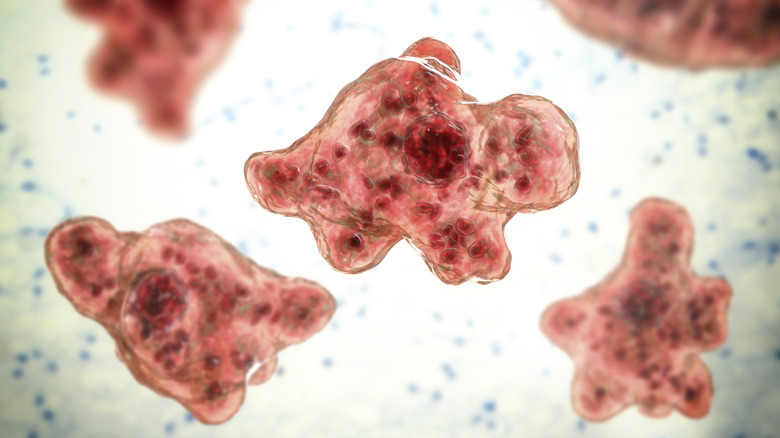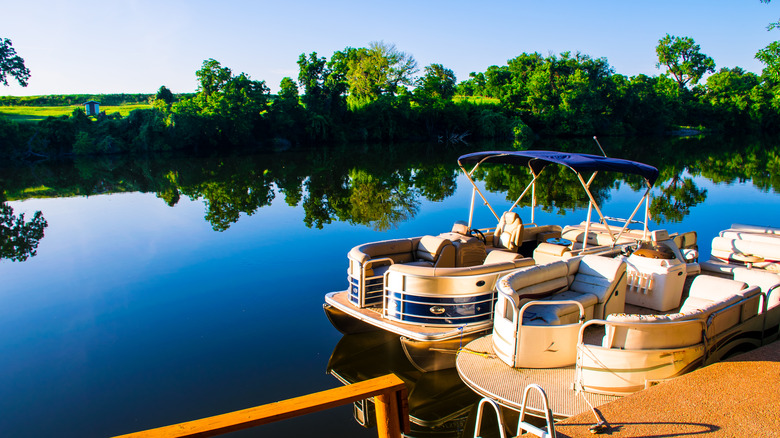The Horrifying Deadly Reason To Avoid Swimming In Texas' Popular Lyndon B. Johnson Lake
Millions of people across the United States head to the nation's thousands of lakes and reservoirs each year to cool off during the hot summer months. Americans certainly have plenty to choose from and some of the best combine breathtaking natural splendor, charming lake towns, and outdoor fun. Venturing into any body of water comes with hazards, however, from drowning and pollution to lethal accidents involving other people. In 2023, it emerged that one popular spot in Texas harbored a deadly peril that sounds like something from a horror movie: A brain-eating amoeba in Lyndon B. Johnson Lake in Texas caused the tragic demise of one unfortunate swimmer.
Located a little more than an hour's drive from downtown Austin, Lake LBJ is one of seven bodies of water that form the Highland Lakes chain on the Colorado River. It is a reservoir that was formed after the construction of Wirz Dam in 1948. Originally called Granite Shoals Lake after the town on its north side, it was renamed in honor of the 36th U.S. President in 1965. With 200 miles of shoreline and a constant water level, Lake LBJ has become a go-to spot for many water-based activities including fishing, boating, hiking, and of course, swimming. Cabins and vacation homes can be found all along the waterfront, and Camp Champions caters to kids aged 5 to 17 in the summer. But now a threat has been revealed that makes this reservoir one dangerous lake to avoid swimming in, and its name is Naegleria Fowleri.
What exactly is a brain-eating amoeba?
The term "brain-eating" might conjure up shudder-inducing images of ravenous zombies or alien slugs from horror movies, but Naegleria Fowleri is a far smaller fiend. It is a single-celled organism (amoeba) that lives in fresh water and flourishes in temperatures between 80 and 115 degrees Fahrenheit. As a result, more cases tend to occur in southern states during scorching summer months, and record-breaking heat waves in recent years have made infections more common. The amoeba enters the body through the nose and makes its way up to the brain where it eats away at tissue, causing bleeding and swelling. The infection, known as primary amebic meningoencephalitis (PAM) causes symptoms such as fever, nausea, vomiting, seizures, and hallucinations. It can take up to 12 days to kick in and the end result is usually fatal — around 97% of cases result in death and, as of September 2023, only four patients in the United States had survived.
The brain-eating amoeba made headlines in August 2023 when a Travis County resident contracted the infection after swimming in Lake Lyndon B. Johnson. The condition is thankfully rare with only 164 recorded cases in the United States between 1962 and 2023, per the Centers for Disease Control. At least 40 of them occurred in Texas. The bad news is that as temperatures rise due to climate change, scientists believe that the infection may become more widespread. Naegleria Fowleri isn't limited to lakes — It can live in hot springs, swimming pools, and even tap water.
Staying safe in LBJ Lake
While Primary Amebic Meningoencephalitis (PAM) is very rare, the amoeba that causes it is extremely common in most fresh bodies of water. So common, in fact, that experts say that we should assume that Naegleria Fowleri is present in any lakes or rivers in Texas, according to KUT News. Indeed, the amoeba is so widespread that the Centers for Disease Control and Prevention (CDC) warn against putting up signs to alert swimmers because it might lead people to think any spot without signage might be safe from infection.
That isn't to say the risk of brain-eating amoebas should totally ruin your summer fun. Currently, cases are still very rare and there are things you can do to limit the chances of contracting the horrible condition if you fancy a dip in Lake LBJ or any popular lake in the United States. Perhaps the most important precaution is making sure water doesn't enter your nasal cavity by wearing a clip or holding onto your nose, especially if you are diving or jumping in. Keep your head above water and try not to disturb silt in shallow warm water, as the amoeba also thrives in the sediment at the bottom of rivers and lakes. Sadly, the best way to avoid an infection is by foregoing water-based fun during high temperatures. While it is so tempting to take a splash when the weather is hot and water levels are low, that is also when Naegleria Fowleri is at its most prolific.


